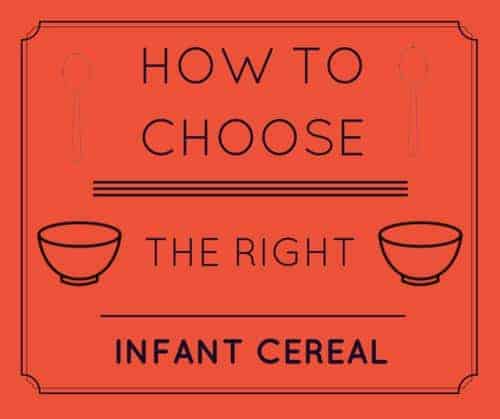
Welcome to Part 6 of my 8 part series: A Dietitian’s Guide to Infant Cereal. My goal in writing this series is to provide you with the education you need about these cereals to make an informed choice about when and what cereals you’d like to feed your baby. To stay connected with me and receive updates on this series, subscribe via RSS, or like Smart Nutrition on facebook!
Part 1: Infant Cereals: Sugarbowls in Disguise?
Part 2: A Brief History of Infant Cereals
Part 3: The Pros and Cons of Infant Cereals
Part 4: Can Babies Digest the Starch in Infant Cereals?
Part 5: Should I Make My Own Infant Cereal?
Part 7: Myths About Infant Cereal
Part 8: 5 Ways to Use Infant Cereal
Types of Infant Cereal
There are two types of infant cereal:
- Add breastmilk or formula: This kind only has the grain and added vitamins/minerals (some brands also add pre or probiotics).
- Add water: In addition to the grain and added vitamins/minerals, this type also has milk powder and a vegetable oil (some brands also add pre or probiotics).
Essentially, the “add water” variety already has formula powder in it.
I prefer the “add breastmilk or formula” varieties. Since you already know that your child tolerates his breastmilk or formula, you are only adding one new food: the rice, wheat, or whatever grain variety is in the cereal.
You’ll notice that the flavours are more limited with the “add breastmilk or formula” variety. That’s okay: it’s only a small sacrifice. You can add pureed apples, bananas, or yogurt when you make the cereal for your baby.
Choosing A Grain: Wheat, Rice, Barley or Oats?
In 2012, rice and products made from rice came under fire for the level of arsenic they contain. Interestingly, humans may actually need to have some arsenic in their diets. Currently, there aren’t any studies on humans but when animals are deprived of arsenic, their growth suffers and reproduction is abnormal. As the saying goes: the dose makes the poison.
So, at what level does arsenic become a toxic poison? Well, the exact amount is unknown. Long-term exposure at high amounts has been associated with an increased risk of certain cancers. In the US, the Food and Drug Administration is running a risk assessment that will hopefully shed some light on what risk the consumption of rice has and at what level.
Until then, a prudent practice would be to eat rice in moderation! What does that mean for infant cereal? Choose a variety of grains to feed your baby: wheat, barley, and oats are all readily available.
Part 1: Infant Cereals: Sugarbowls in Disguise?
Part 2: A Brief History of Infant Cereals
Part 3: The Pros and Cons of Infant Cereals
Part 4: Can Babies Digest the Starch in Infant Cereals?
Part 5: Should I Make My Own Infant Cereal?
Part 7: Myths About Infant Cereal
Part 8: 5 Ways to Use Infant Cereal
[share title=”Share This Article” facebook=”true” twitter=”true” google_plus=”true” linkedin=”true” pinterest=”true” reddit=”true” email=”true”]


Hello Jessica, thank you so much for this post! My son is allergic to gluten, and there is often cross-contamination with oats. I don’t want him to only eat rice as his grain due to the concerning level of arsenic. If he is already taking an iron-vitamin, do I actually need to give him “iron-fortified” cereals? Does he need grain in his diet? If so, what kind of grains would you recommend? Thanks!
Hi Linda,
I would recommend you discuss your son’s iron needs with his primary healthcare provider. And when there’s an allergy, that’s no longer a case of generalized nutrition so I’d recommend discussing your son’s diet needs with a dietitian who could review his diet for nutritional adequacy!